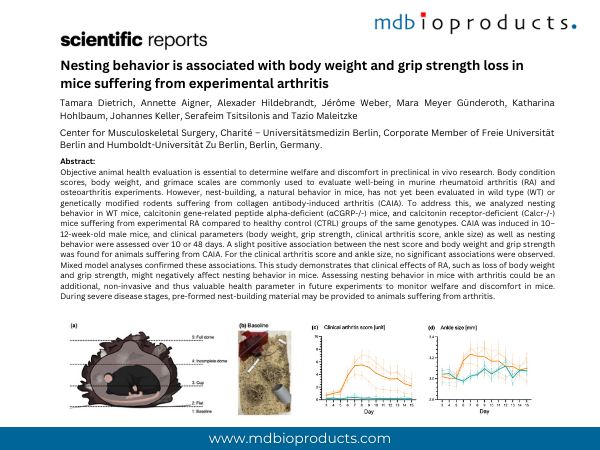
Featured Publication in Focus: Nesting behavior is associated with body weight and grip strength loss in mice suffering from experimental arthritis
Jun 04 , 2024
Authors:
Tamara Dietrich, Annette Aigner, Alexader Hildebrandt, Jérôme Weber, Mara Meyer Günderoth, Katharina Hohlbaum, Johannes Keller, Serafeim Tsitsilonis and Tazio Maleitzke
Center for Musculoskeletal Surgery, Charité – Universitätsmedizin Berlin, Corporate Member of Freie Universität Berlin and Humboldt-Universität Zu Berlin, Berlin, Germany.
Springer Nature. Scientific Reports
----------------------
Product referenced:
Catalogue # CIA-MAB-2C
ArthritoMab™ Antibody Cocktail for C57BL/6, TG, 50 mg
----------------------
ABSTRACT
Objective animal health evaluation is essential to determine welfare and discomfort in preclinical in vivo research. Body condition scores, body weight, and grimace scales are commonly used to evaluate well-being in murine rheumatoid arthritis (RA) and osteoarthritis experiments. However, nest-building, a natural behavior in mice, has not yet been evaluated in wild type (WT) or genetically modified rodents suffering from collagen antibody-induced arthritis (CAIA). To address this, we analyzed nesting behavior in WT mice, calcitonin gene-related peptide alpha-deficient (αCGRP-/-) mice, and calcitonin receptor deficient (Calcr-/-) mice suffering from experimental RA compared to healthy control (CTRL) groups of the same genotypes. CAIA was induced in 10–12-week old male mice, and clinical parameters (body weight, grip strength, clinical arthritis score, ankle size) as well as nesting behavior were assessed over 10 or 48 days. A slight positive association between the nest score and body weight and grip strength was found for animals suffering from CAIA. For the clinical arthritis score and ankle size, no significant associations were observed. Mixed model analyses confirmed these associations. This study demonstrates that clinical effects of RA, such as loss of body weight and grip strength, might negatively affect nesting behavior in mice. Assessing nesting behavior in mice with arthritis could be an additional, non-invasive and thus valuable health parameter in future experiments to monitor welfare and discomfort in mice. During severe disease stages, pre-formed nest-building material may be provided to animals suffering from arthritis.
To continue reading and to download the publication:
